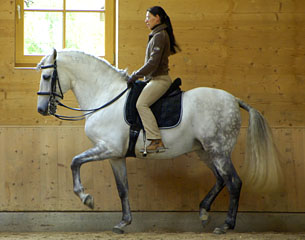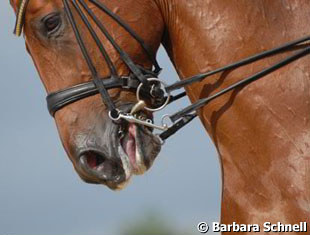
There are many elements inherent in the art of classical riding and while self-carriage, lightness, compassion, and "descente de main" are all key components, so too is the art of establishing the classical seat.
"Of course there is such a thing as a classical seat," says classical rider and trainer Anja Beran. "A classical seat has a rider who is completely in balance with his horse and who never disturbs the horse!"
This made me wonder again about the perfect position and if in fact such a thing exists. Working at home on the lunge with mum, I listened carefully to her advice as to how better to improve the relaxation of my hip and wrists, my two major points of tension.
When I returned to Portugal I found the more I focused on the correct position, the worse my horse went. I found that it is more about finding the correct position for you that enables you to relax and flow with the horse, and this must be adjusted according to the horse you are riding at the time.
I then started looking at old videos of famous riders, focusing on where they sat and I found that each one, while obviously gifted, was unique. Some of the top riders held their legs back and their toes forward, while others had their legs more on the girth with their feet facing outwards. Some held their hands up and forward, while others, while still remaining soft, were on the horse's neck.
Anja is right, a perfect position is nothing if it does not go with the horse and a classical, or I would say beautiful seat, is just one that never interferes, and thus allows the horse to feel completely at ease within the rider's rhelm. Obviously then, a seat that disturbs or restricts the horse is not classical, nor is it effective in the goals of dressage.
A rider must use his seat with compassion, understanding, and relaxation, in the same way his mind must be relaxed and he must carry himself and thus allow his horse to do the same.
"Every rider who needs the reins to balance himself on the horse has no classical seat," says Anja. "A classical rider should be able to coordinate his body in all parts, he should sit really in the middle of the horse and should not hang to one side."
The most crucial component then, in establishing a classical seat, is rider balance and trust; trust that if he creates the safe environment above the horse, the horse will relax underneath him and carry him smoothly along.
"A rider with a classical seat should have elastic hips that follow the flow of the horse in every moment. He should never fall backwards (behind the movement) or hang on the neck of the horse. He should have relaxed arms and legs, soft hands and fingers but he should have a “strong” back and belly with muscles that work well. The seat is the most important thing for classical riding and the welfare of the horse! Many horses suffer a lot and have back pain or get at least problems with their health (legs, back) just because of a wrong and brutal seat of their rider!"
 Therefore, the art of establishing a classical seat is not by imitation nor instruction, but by feel; feeling when your horse relaxes and where, given your physical stature and ability, you too find your point of optimum relaxation and minimum interference!
Therefore, the art of establishing a classical seat is not by imitation nor instruction, but by feel; feeling when your horse relaxes and where, given your physical stature and ability, you too find your point of optimum relaxation and minimum interference!
Once a rider has established a classical seat, wherever that may be for them, they next need to learn how to move from a classical working seat, to a classical collected seat, without disturbing the attitude, rhythm, or balance of the horse, (ie pulling on the reins).
"To achieve this the rider must first of all have a good teacher, and some lunge lessons, as gymnastic work on the horse can help a lot," sayd Beran. "Then it is important for them to get some lessons on a “high school” horse, because it is the well ridden horse that gives us an idea how we should sit and use our bodies."
Anja makes an excellent point and while we can learn with our equine partners, it is always better to have a master (schoolmaster) to allow us to feel it, so we can transfer that feeling onto our own horse.
"It is also helpful to sit on a horse that makes a good piaffe, because the piaffe can put the rider in a perfect balanced position, as the back of the horse works very well in this movement."
If you don't have access to a ready made Grand Prix master, schooled in piaffe Anja says that at the very least it is important to do some gymnastic exercises without the horse, for example pilates, yoga or ballet, depending on you and your individual problems.
"That main thing to remember is that coordination of the body and mobilisation, is the basis for a good rider!"
Trainer Richard Weis points out that a working seat and a collected seat have to be different because they are asking different responses from the horse. "Simply put, a collected seat asks the horse to express more energy with more lift," says Richard. "Not surprisingly, the horse gets this idea because the rider takes on the same features – more energy - more lift. More energy comes from a higher tone, more lift comes because the spring from that higher tone is concentrated vertically."
Therefore, Richard notes that a picture taken from the side of a good collecting seat would be narrower than a picture of a working seat. "The vertical intensity is achieved by the rider bringing the whole back forward in the saddle. The thigh drops more vertically back and down making a straighter hip joint angle," Weis explained.
Richard agrees that a great way to experience that form of seat is to get a ride on a horse with really good piaffe, one worked in hand by a skilled trainer. "Just sit there, and do nothing! As the trainer brings the horse's back up into piaffe you‘ll feel yourself lifted to the front of the saddle and carried high," he stated.
Richard advises that sitting on piaffe is a good way to feel the shape, but says however that there is little or no bounce in a good piaffe like there is in collected trot. "In training, collected trot is on the way from working trot moving towards piaffe. It has bounce, not as much as working trot, but less than good piaffe, which isn't bouncy at all," he said. "A good collected trot feels more like being buoyed up on a powerful fountain...tremendous power, dynamic stillness."
Richard has found that it is when all this energy, all this effort, is distributed throughout the entire body and not concentrated and blocked in say in the neck, shoulders or lumbar area as we often see, that true collection is found.
So then if a collected seat, as all the classical journals agree, requires more impulsion, more energy, more lift, from the horse, I often wonder why then, do so many riders try to gain collection by pulling on the reins?
"Hahaha – ask them! I don´t understand this either," Anja laughed! "The truth is that there are not enough good teachers and less school masters (means really trained to high school). The training to become a professional rider is much too short, in two years you will never get a good seat."
That's why the Anja foundation keeps the young riders here for 6 years to become good trainers. "Most of the people don't know what collection is and how it feels to sit on a collected horse. It means being really in balance and harmony with the horse, where you don´t need legs and reins anymore."
 For true collection Anja describes the brilliance of the horse, where horse and rider are like one body! "But to achieve this the riders have to do a lot of exercises to prepare the horse for the collection and these exercises are nowadays almost forgotten. That is the biggest problem," she said. "Instead people have heard the horse needs impulsion so they use body, legs, spurs, and all they have, to push the horse. Then they hear that the horse needs to be short in the movement and high in the neck so at the same time they pull on the reins!"
For true collection Anja describes the brilliance of the horse, where horse and rider are like one body! "But to achieve this the riders have to do a lot of exercises to prepare the horse for the collection and these exercises are nowadays almost forgotten. That is the biggest problem," she said. "Instead people have heard the horse needs impulsion so they use body, legs, spurs, and all they have, to push the horse. Then they hear that the horse needs to be short in the movement and high in the neck so at the same time they pull on the reins!"
According to Anja, the result is a rider that is always needing more legs than hands, if not the horse will stop, and to keep this up they really need horses with a very good temperament and character, with strong bodies and movements, as a “normal” horse cannot work under such contraction and pressure.
"Another common error is that riders use for the “light” work, like walk or collected trot, a lot of leg and spurs all the time, so the horses get very lazy because they become numb to the leg aids. They start to ignore the legs because no matter how they react, the aids will never stop, and it is the same with using the reins! So in the end, there is no classical art with horses and riders in harmony, lightness and balance, but the contrary, where riders and horses are completely in a sweat, pulling on the reins, horse on the forehand, showing contraction and pressure. Many riders have no idea of a classical seat anymore and instead they try to build up muscles in their arms and legs to be able to control the horses better, that's completely the wrong way!"
All this sounds familiar, we have all seen it, so then I asked Anja, how then do we tell if a rider has a classical seat and what must we look for in the horse, to confirm our impression? "Watch the horse! Is the horse happy and brilliant, do you have the impression he works almost “alone” and the rider is just part of him? Does the horse breathe well? Does he chew on the bit and is he relaxed? Are his three natural gaits okay? Do you hear any noise when the horse is breathing? Does the horse move his tail all the time? Does he make a noise with the teeth or does he even shake his head or neck? Is the neck very short and the nose behind the vertical? Does the horse walk well or like a camel? Is the trot diagonal or is the line broken, meaning does the horse use the forehand more than the hindquarters?"
All these points give us an answer about the seat of the rider! Why? "Because a bad seat hurts the back of the horse and without the back nothing is possible anymore! A horse will no longer be able to move well and he will loose his gaits."
So the classical seat is the key!
By Sarah Warne for Eurodressage
Related Link
Sarah Warne's Classical Training Articles